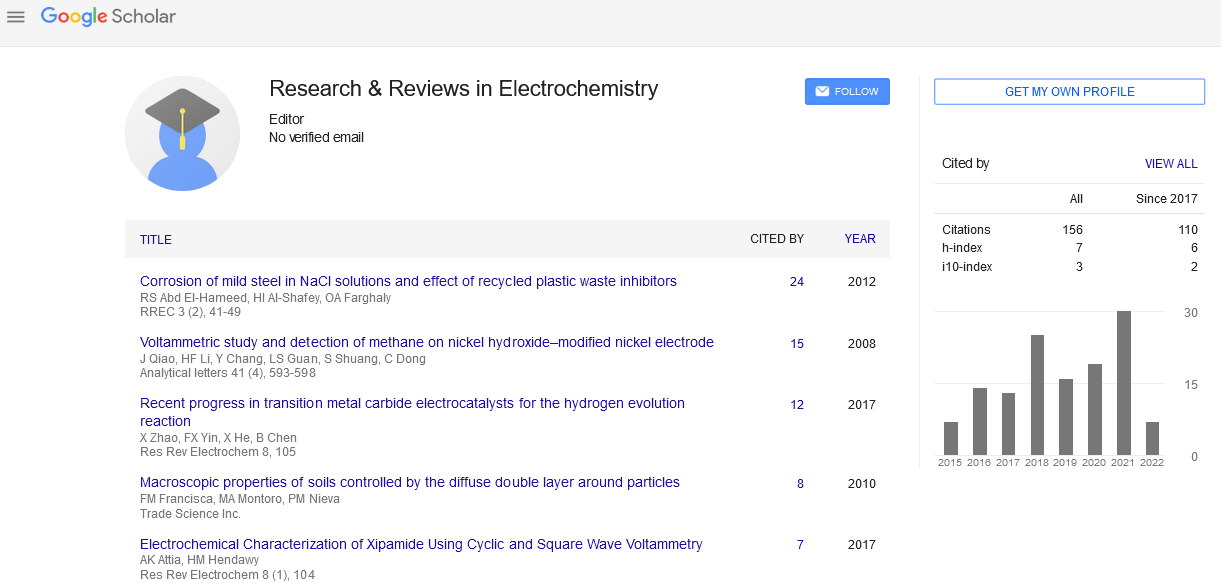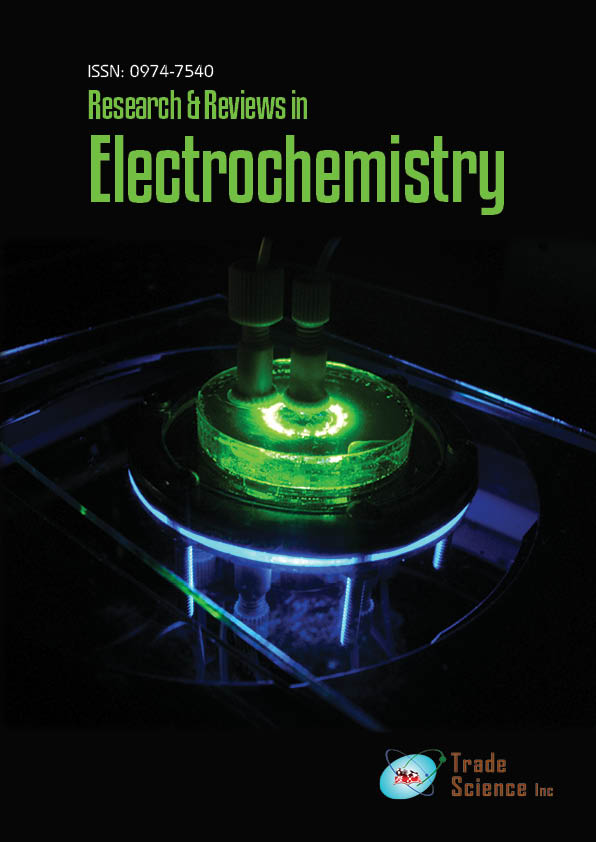Viewpoint
, Volume: 12( 4) DOI: 10.37532/0974- 7540.22.12.4.250Redox Electrolytes for Supercapacitors
- *Correspondence:
- Jacob Koehler
Editorial Office, Research and Reviews in Electrochemistry, UK
E-mail:electro.med@scholarres.org
Received: 5-July-2022; Manuscript No. tsrre-22-72683; Editor Assigned: 19-July-2022; PreQC No. tsrre-22-72683 (PQ); Reviewed: 24-July2022; QC No. tsrre-22-72683 (Q); Revised: 29-July-2022; Manuscript No. tsrre-22-72683 (R); Published: 31-July-2022, doi no. 10.37532/0974- 7540.22.12.4.250
Citation:Koehler J. Redox Electrolytes for Supercapacitors. Res Rev Electrochem 2022;12(4):250
Abstract
Because of their short charging/discharging time, long cycle life, and good temperature characteristics, supercapacitors (SCs) have received a lot of attention. Electrolytes have been identified as a critical factor influencing the performance of SCs. They derive the majority of their energy density from their decomposition voltage and the majority of their power density from their ionic conductivity. Redox electrolytes have gained popularity in recent years due to their additional redox activity, which provides increased charge storage capacity in SCs. This article summarises the most recent advances in the study of redox electrolytes, focusing on their properties, mechanisms, and applications based on the various solvent types available. It also suggests potential solutions for increasing the energy density of SCs while maintaining their high power and long life.
Introduction
Supercapacitors (SCs) are a new type of energy storage device that bridges the gap between secondary batteries and conventional capacitors. Because of their fast charging/discharging capability, long cycle life, high power density, and high safety, SCs are thought to be one of the most promising candidates. SC research has primarily focused on the preparation and modification of electrode materials to improve capacity over the course of decades of development. Electrolytes, as an important component of SCs, provide ionic conductivity and promote electrode charge compensation, so the performance of the SCs is determined by the electrolyte in conjunction with the electrode material. The electrolyte has two important properties: (1) The window of electrochemical stability. If the electrode material does not undergo any decomposition reaction within the voltage range of the SCs, the output voltage of the device is largely determined by the electrolyte's decomposition voltage. (2) The conductivity of ions. It influences the dynamic process and determines the SCs' rate capability. It is proportional to the number of carriers, the ionic charge, and the carrier mobility. Aqueous electrolytes, organic electrolytes, ionic liquid electrolytes, all solid electrolytes, gel electrolytes, and redox electrolytes are the most common types of SCs electrolytes. Several reviews on electrolytes for SCs have previously been published. However, none of the previous reviews focused on the relationship between the properties, mechanisms, and applications of redox electrolytes and the various solvent types available. Redox electrolytes are a type of electrolyte that contains redox active species. They can significantly improve SC electrochemical performance for two reasons: (1) the electrolyte additive is an active component of the SCs in redox reactions during charge and discharge processes. (2) The electrolyte's redox reactions promote electron transfer between the electrode material and the electrolyte's redox species. This review primarily summarises the most recent research findings concerning various redox electrolytes based on aqueous, organic, ionic, and gel solvents.
Aqueous electrolytes with redox mediation
There are three types of aqueous electrolytes: acidic, alkaline, and neutral solutions. Sulfuric acid aqueous solution, as a commonly used electrolyte, has both high ion conductivity/concentration and low equivalent series resistance. As a result, adding redox additives to aqueous sulfuric acid solution is a good way to optimise the electrolyte and improve SC performance. KI, Na2MoO4, Ce2(SO4)3, Fe3+/Fe2+, viologen substances, 1,4-dihydroxyanthraquinone, hydroquinone (HQ), and other redox additives are examples.
Organic electrolytes with redox mediation
An organic electrolyte with a broad electrochemical stability window (around 3 V) is a good choice for increasing energy density. Organic solvents and conductive salts make up the organic system. The most commonly used solvents in SCs are Propylene Carbonate (PC) and Acetonitrile (AN). The most commonly used salts in SCs are Tetraethyl Ammonium Tetrafluoroborate (TEABF4) and LiPF6.
Ionic liquid electrolytes with redox mediation
Ionic liquids are typically made up of a bulky, asymmetric organic cation and a weakly coordinating inorganic/organic anion with a broad electrochemical window (generally above 3.5 V), high electrochemical stability, good oxidation resistance, and other properties. Quinones have recently been discovered to be excellent redox electrolyte additives in ionic liquid electrolytes. The incorporation of hydroquinone (HQ) and benzoquinone (BQ) as organic redox shuttles into the electrolyte results in low charge transfer resistance and contributes to the improvement of SC specific capacitance and specific energy.
Gel electrolytes with redox mediation
Gel is a unique material that combines the flexibility and stability of a solid with the ease of liquid diffusion. It has a number of advantages, including higher ionic conductivity than solid electrolytes and good mechanical and chemical stability, among others, making it a promising electrolyte. A novel redox-mediated strategy for SCs was recently reported, which can efficiently increase ionic conductivity and produce additional capacitance via the redox mediator's quick reversible redox reaction. Indigo Carmine (IC), 2-mercaptopyridine (PySH), 1-butyl-3-methylimidazolium iodide (BMIMI), Alizarin Red S (ARS), FeBr3, 1,4 Naphthoquinone, 1-anthraquinone sulfonic acid sodium (AQQS), and 1-ethyl-3-methylimidazolium tetrafluoroborate are common redox additives ([EMIM]BF4).

